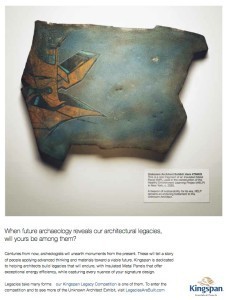Kingspan: Legacies are Built
 The rebirth of human society can be attributed as much to the innovators and pioneers of today as it can be to the legacy left behind by those who came before. Among the ruins of the great cities of our predecessors, the work of one architect rises to outshine all others. It is this Unknown Architect’s ingenuity and commitment to sustainability that we owe our ability to build a new infrastructure, bypassing many of our ancestors’ mistakes.
The rebirth of human society can be attributed as much to the innovators and pioneers of today as it can be to the legacy left behind by those who came before. Among the ruins of the great cities of our predecessors, the work of one architect rises to outshine all others. It is this Unknown Architect’s ingenuity and commitment to sustainability that we owe our ability to build a new infrastructure, bypassing many of our ancestors’ mistakes.
Nothing is known about the Unknown Architect’s personal life, but it can be said with certainty that their work was prolific, revolutionary and in high demand. Near the beginning of our new society’s short history, as we began to reconnect the scattered remnants of the human race, we exchanged our knowledge and our stories.
One fact soon became clear; every successful society had in their possession, remnants of buildings designed by the Unknown Architect. Archaeologists and art historians have analyzed the old buildings – the Seed Buildings, as they are sometimes called – and have determined that they are all indeed the work of the same, Unknown Architect. Every world-class city from The Time Before features a Seed Building designed by the Unknown Architect: New York, Los Angeles, Paris, Rome, London, Toronto, Dubai, Sydney, Tokyo, Hong Kong, Beijing, Berlin, Moscow, Singapore, Jerusalem and others all have at least one building that bears the signature design sensibility of the Unknown Architect. It was from these Seed Buildings that we learned the ways to build a beautiful and functional world. From these Seeds we grew environments that have supported and nurtured us throughout our rebirth as a people.
When future archaeology reveals our architectural legacies, will yours be among them?
Centuries from now, archeologists will unearth monuments from the present. These will tell a story of people applying advanced thinking and materials toward a viable future. Kingspan is dedicated to helping architects build legacies that will endure, with Insulated Metal Panels that offer exceptional energy efficiency, while capturing every nuance of your signature design.
Legacies take many forms and our Kingspan Legacy Competition is one of them. To enter the competition and to see more of the Unknown Architect Exhibit, visit LegaciesAreBuilt.com
Healthy Environment Learning Project (HELP) (Sydney)
This is a fragment of an Insulated Metal Panel, used in the Healthy Environment Learning Project (HELP) in Sydney, Australia, c. 2017. HELP blended seamlessly with Sydney Harbour’s natural environment. It generated all of its own power, treated collected rainwater and filtered wastewater with naturally occurring biological systems.
Manhattan Arcology (New York)
This fragment is from a wall of the Manhattan Arcology, c. 2047. An octahedron suspended on legs that spanned the breadth of the north end of Manhattan Island, the Manhattan Arcology housed over a million people. Living, work and leisure spaces intermingled with green spaces, supported by a core of sustainable infrastructure and the most advanced urban farm of its time.
Gulf Coast Habitat (New Orleans)
A piece of the roof section of The Gulf Coast Habitat, c 2021. It was the most self-sustaining building of the day. Instead of a single building, the Habitat is a flotilla of interconnected structures, built on buoyant foundations designed to rise and fall with the water level. As the sea swallowed New Orleans during the worst of the storms, the Habitat survived, housing tens of thousands of people.
Spirit Arts Center (Los Angeles)
Digitally restored recreations of the Center show an ebony jewel glinting with chrome accents and thousands of solar-powered LEDs. During the day it stood as a monolithic monument to the art of a generation and on clear nights it blended with the starry sky.
Museum of Modern Culture (London)
Although little of the structure remains in place today, the Museum of Modern Culture in London, England was once a shining example of high function blended with high art. The museum stood on the north bank of the River Thames, a cathedral of crystal mirrors. Its entire surface was a network of solar energy collectors, and subterranean conduits as well as preserved documentation found on the museum’s site suggest that it not only provided enough electricity for itself, but also for several surrounding blocks of urban London.
Men de Mingxing Spaceport (Hong Kong)
Men de Mingxing Spaceport was built at the height of the space tourism industry. Built on an artificial extension of the island of Hong Kong made from clean waste, Men de Mingxing was a stunning marriage of form and function. Heat and wind captured from rocket launches powered every conceivable automated convenience for passengers.
Aquatic Athletics Centre (Toronto)
The entire Centre was partially submerged in Lake Ontario and used naturally purified lake water to fill its pools. A canopy of ultrathin tempered glass shaped like crashing waves and swirling water floated on a lightweight transparent structure, giving the impression that the whole building was a foaming wave on the lake, frozen in time. Natural solar heat focused through the canopy heated the pools.



